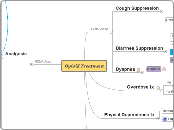Opioid Treatment
Not approved for clinical use!
Heroin
strong opioid agonist
more lipid soluble and faster acting than morphineeuphoriaPhycial Dependence tx
Buprenorphine
in addition to analgesia, also tx opioid addictionsafer and as effective as methodonealso used to tx depresion and in smoking cessation programsMethodone
strong opioid agonist
orallong duration, so less severe withdrawal syndromealso has good analgesia for cancer and neuropathic paincross tolerance decreases heroin's reinforcing propertiesno euphoriaOverdose tx
both are pure competitive opioid antagonists --> can preciptate opioid withdrawal(oral)
Naltrexone
to dx opioid dependencecan also reduce craving for alcoholNaltrexone + Clonidine or Buprenorphine = rapid opioid detox(IV)
Naloxone
to reverse opiod overdose and toxicity
short duration of action (so you need to maintain vigilance around the patient - they might go back into opioid-induced respiratory depression)
only partially reverses tramadol
doesn't reverse pentazocine or buphrenorphine at all
LOW dose
Dyspnea
for dyspnea associated with acute pulmonary edema secondary to acute left ventricular failure
morphine's ability to relieve SOB is due to:
1) decreased peripheral RESISTANCE
2) slowing of RESPIRATION
3) relief from ANXIETY
Diarrhea Suppression
Loperamide
weak opioid agonist
minimal dependence riskpoorly absorbeddoesn't cross BBBDiphenoxylate (+ atropine)
weak opioid agonist
minimal dependence riskcombined with atropine to decrease misuse by IV routeCough Suppression
Dextromethorphan
less constipating than codeineno analgesic activityno dependence riskdizziness
nausea
overdose: seizures
HIGH dose
Anesthesia
very high dose
less constipating effect than codeineno analgesic activityno dependence riskAE:
dizzinessnauseadrowsinessAnalgesia
moderate pain
Buphrenorphine
Pentazocine
for moderate pain (has analgesic ceiling)resistant to naloxone reversalhallucinations
anxiety
dysphoria
may increase BP
CONTRAINDICATED FOR MI'sneuropathic pain
Tramadol
for neuropathic painenhances 5-HT and NE neurotransmission by blocking reuptake (makes you happier)actions partially reversed by naloxoneNO effect on respirationincreased risk of seizures
CONTRAINDICATED IN PATIENTS WITH EPILEPSY OR PATIENTS TAKING MAOI'S (lower seizure threshold)Meperidine
strong opioid agonistno effect on cough reflexlargely replaced by other opioidsw/ MAOI
"serotonin syndrome"
severe restlessnessexcitementfeverseizuresdeliriummidriasis
d/t weak anticholinergic activitynote: this is OPPOSITE from what you would expect with an opioid!vomiting
less than with morphine
Overdose: CNS excitation, seizures
due to formation of N-demethylated metabolite (normeperidine) -- no analgesic activityCodeine
weak opioid agonist
also Oxycodone, Hydrocodone, Dihydrocodeinegets its analgesic activity from conversion to morphine (10% is converted)good oral bioavailability (unlike morphine)less respiratory depression than morphinehydrocodone + acetaminophen = Vicodin/Lortaboxycodone + acetaminophen = Percocetoxycodone + aspirin = Percodanless than morphine
preanesthetic
Fentanyl
strong opioid agonistrapid onset, short durationIV100x more potent than morphineused during labor, as preanesthetic, and for pre-, intra-, post-op, & breakthru paincan use for "balanced anesthesia" (ie to supplement the analgesia and sedative-hypnotic effects of NO and halothane)Fentanyl + droperidol = Innovar (induces neuroleptanalgesia, permitting wakeful state when cooperation is needed during surgery)can be given in transdermal patch or lollipop for breakthru painminimal constipation
minimal respiratory depression
minimal cardiac depression
severe musc. rigidity
on rapid IV administration
Morphine
strong opioid agonistIVundergoes significant first pass metabolism when taken orallydrug interactions
drugs that add to sedation or cause respiratory depression
w/ SSRI, MAOI, or TCA (incr. serotonin)
cause "serotonin syndrome"AE:
other
pruritis
prolonged labor
GI/Kidney/Gallblader
increased tonepainful biliary spasm
painful urine retention
constipation
CV
postural hypotension
CNS
miosis
= constrictionexception: Meperidinepneumonia
tolerance & dependence
N/V
drowsiness
respiratory depression

